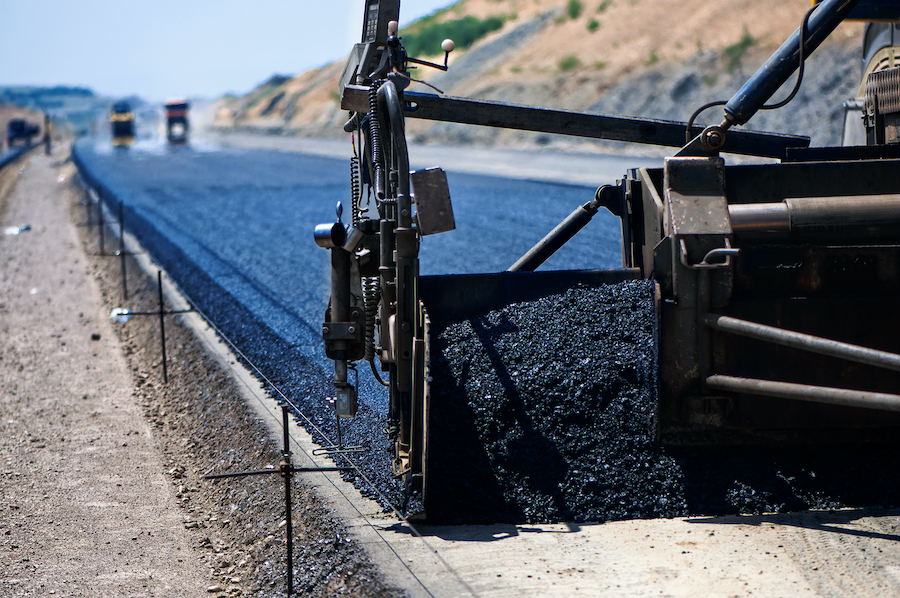
Our Asphalt Design Guide article series, based on the Asphalt Paving Design Guide by Minnesota Asphalt Pavement Association, will give you information about using asphalt in your construction projects. In our second article, we discussed design considerations such as traffic, soil support capability, and pavement thickness. In this third article we discuss parking lot design.
General Considerations in Parking Lot Design
The parking lot is often the first, as well as the last, experience that a user has of a building complex.
Parking areas with pavements that are initially under-designed can experience excessive maintenance problems and a shortened service life, and ultimately have a negative impact on the user’s experience of the building itself.
When properly designed and constructed, parking areas can be an attractive part of the overall facility, an integral element that is safe, and functional to the maximum degree. In addition, parking areas should be designed for low maintenance costs and easy modification when use patterns change.
General Planning
You will want to maximum parking capacity while ensuring convenience and safety. If the locality does not have a zoning ordinance identifying specific requirements for off- street parking, the general recommendations in the below table may be useful.
Recommended Parking Requirements
| Land Use | Spaces/Unit |
| Residential | |
| Single-Family | 2.0/Dwelling |
| Multifamily
Efficiency 1 -2 Bedroom Larger |
1.0/Dwelling 1.5/Dwelling 2.0/Dwelling |
| Hospital | 1.2/Bed |
| Auditorium/Theater/Stadium | 0.3/Seat |
| Restaurant | 0.3/Seat |
| Industrial | 0.6/Employee |
| Church | 0.3/Seat |
| College/University | 0.5/Student
|
| Retail | 4.0/1000 GFA |
| Office | 3.3/1000 GFA |
| Shopping Center | 5.5/1000 GLA |
| Hotels/Motel | 1.0/Room
0.5/Employee |
| Senior High Schools | 0.2/Student
1.0/Staff |
| Other Schools | 1.0/Classroom |
GFA, sq. ft. of gross floor area GLA, sq. ft. of gross leasable area

Parking Space Optimization
Rules have been developed for optimizing parking area space, including:
- Use rectangular areas where possible.
- Make the long sides of the parking areas parallel.
- Design so that parking stalls are located along the lot’s perimeter.
- Use traffic lanes that serve two rows of stalls.
Special attention should be given to the flow of traffic in and out of the lot as well as circulating routes inside the lot. Keep entrances far away from busy street intersections. Be sure that the entering vehicles can move into the lot on an internal aisle, thereby avoiding congestion caused by turning vehicles. A pedestrian traffic-flow study will provide information about both safety and convenience.
Parking Angle
The most popular angles for parking stalls are 45°, 60°, and 90°. The 60° angle is the easiest to use as it permits reasonable traffic lane widths and eases entry and exit of the parking stall. Where lot size restricts the dimensions available for aisles and stalls, a 45° angle may be used. The 90° parking angle provides the most parking spaces for a given area. This type of parking is more suited to all-day parking as the stalls are difficult to enter and exit.
Parking Space Dimensions
The minimum width for public use parking spaces is 9 feet by 19 feet. Recommended stall dimensions for compacts and similar-sized vehicles are 7 1/2 feet by 15 feet. Stall widths for parking lots where shoppers generally have large packages, such as supermarkets, should be 9 1/2 feet or even 10 feet wide.
Parking Lot Markings
The parking area should be clearly marked to designate parking spaces and to direct traffic flow. As specified in the Manual on Uniform Traffic Control Devices (MUTCD), parking on public streets should be marked out by using white traffic paint, except for dangerous areas, which should be marked in yellow. All pavement striping should be 4 inches in width.
Construction Practices
Drainage Provisions
Drainage provisions must be carefully designed and installed early in the construction process. Parking area surfaces should have a minimum slope of 2 percent (2’ per 100’). They should be constructed so water does not accumulate at the pavement edge. An underdrain system may be required to carry water away from the pavement structure.
The use of asphalt pavement base (compared to use of aggregate base) will greatly reduce the potential for strength and stability problems related to water.
Subgrade Preparations
All underground utilities should be protected or relocated before grading. All topsoil should be removed. Laboratory tests are recommended to evaluate the load-supporting characteristics of the subgrade soil. However, designs are frequently selected after careful field evaluations based on experience and knowledge of local soil conditions.
The area to be paved should have all debris and vegetation removed. Grading and compaction of the area should be completed so as to eliminate yielding or pumping of the soil.
The subgrade should be compacted to a uniform density of 95 percent of the maximum density. This should be determined in accordance with standard density (Test Method AASHTO T-99). When finished, the graded subgrade should not deviate from the required grade and cross section by more than 1/2 inch in 10 feet.
Areas of the subgrade that are anticipated for asphalt paving may be tested for uniformity and adequacy of support by driving a loaded dump truck at a speed of 2 to 3 mph over the entire surface. Areas that show a deflection of 2 or more inches should be further improved, such as with a compaction subcut or an additional thickness of asphalt pavement.
Asphalt Pavement Surface Course
Material for the surface course should be placed in one or more lifts to the true lines and grade as shown on the plans. The asphalt surface should not vary from established grade by more than 1/4 inch in 10 feet when measured in any direction. Any irregularities in the surface of the pavement course should be corrected directly behind the paver. As soon as the material can be compacted without displacement, rolling and compaction should start and should continue until the surface is thoroughly compacted and roller marks disappear.
Heavily-Loaded Areas
The pavement for entrances, frontage roads, trash dumpster sites, and delivery truck parking, as well as the approach areas to these spaces, must be increased in thickness to prevent pavement failure caused by the weight and dynamic loading of vehicles. These areas should be constructed with a thickness that will support this special type of loading. Failure to provide this strengthening can result in severe pavement failure.
Planned Stage Construction
Planned stage construction is a means of providing fully adequate pavements while effectively using funds, materials, and energy. As defined, it is the construction of an asphalt pavement parking lot or roadway in two or more stages, separated by a predetermined interval of time. In many situations, building pavements in stages makes good economic sense. It is a technique long used by city and county highway engineers.
Stage construction is not maintenance. It is the placement of a minimum depth of pavement during initial construction, and a final surface course placed at a planned future date. Asphalt pavement lends itself to this kind of construction.
Stage construction has the advantage of providing a thoroughly adequate, all-weather pavement for the initial development of an area. Any damage to the Stage 1 pavement caused by traffic, settlement, or utility tearups can be repaired prior to placement of the final surface. With a proper cleaning and an asphalt tack coat, the Stage 2 pavement bonds to the old surface and becomes an integral part of the entire pavement structure.
Miscellaneous Asphalt Pavement Construction
Asphalt Pavement Gutter
An asphalt pavement gutter offers a method of carrying the water in a manner similar to a curb, yet is much easier to plow in the winter.
Asphalt pavement gutters provide a solution to the erosion problem by carrying the water to the bottom of hills and then harmlessly discharging it into a ditch. Construct a spillway at some predetermined midpoint to carry the water from the gutter to the bottom of the ditch or pond.
If the gutter must be crossed to provide access to properties, care must be taken to adequately backfill the gutter with aggregate or, even better, with an apron of asphalt pavement to provide support to the backside of the gutter.
Site Paving
Site paving is the recommended first step in many types of building construction projects. It offers several advantages, providing a working mat or platform for shopping centers, schools, manufacturing concerns, warehouses, and similar facilities.
In this technique, an asphalt pavement base course is constructed on a prepared subgrade over the entire area that will become parking areas, service roadways, and buildings. When building construction is completed, a final asphalt pavement surface course is placed on the asphalt pavement base.
Paving a building site before construction is completed has several benefits, including:
- It ensures constant accessibility and provides a firm platform upon which people and machines can operate efficiently, thereby speeding construction.
- It provides a dry, mud-free area for construction offices, materials storage, and worker parking, eliminating dust control expenditures.
- It eliminates the need for costly select material—the asphalt subfloor ensures a floor slab that is dry and waterproof.
- Steel-erection costs can be reduced because a smooth, unyielding surface results in greater mobility for cranes and hoists.
- The engineer can set nails in the asphalt pavement as vertical- and horizontal-control points, effectively avoiding the risk of loss or disturbance of this necessary survey work.
- Excavation for footings and foundations and trenching for grade beams can be accomplished without regard for the asphalt base.

Construction Practices
Subgrade Preparation
All vegetation (including root systems), rocks, debris, and topsoil should be removed from the area being paved, drainage and utility facilities are installed, then backfill and compact. Adjustments in utilities or underground facilities can be readily accomplished through the asphalt base should changes occur.
The subgrade must be properly shaped to meet true lines and elevations. It must be compacted to not less than 95 percent of maximum laboratory density (AASHTO T-99). The surface of the compacted subgrade must not deviate by more than 3/4 inch from the established grade. A minimum slope of about 2 percent (2’ per 100’) should be maintained to provide adequate drainage of surface water from the finished pavement.
Areas of the subgrade that are anticipated for asphalt paving may be tested for uniformity and adequacy of support by driving a loaded dump truck at a speed of 2 to 3 mph over the entire surface. Areas that show a deflection of 2 or more inches should be further improved, such as with a compaction subcut or an additional thickness of asphalt pavement. When the improvement is completed, the finished grade should be hard, stable and constructed in reasonably close conformance with the lines, grades and proposed typical cross sections to allow for a working platform for paving construction equipment and associated activities. This process can be used to evaluate the stability of aggregate base; however, the deflection should be minimal.
Base-Platform Construction
Asphalt pavement base material must be placed on the prepared subgrade. A base of 4 inches or less in depth should be placed in one lift. A base of a total thickness of more than 4 inches may be placed in two or more lifts with the bottom lift being a minimum of 3 inches. The material must be spread and compacted to the required thickness and density as specified, and in the grades and dimensions shown on the plans. The surface of the base should not deviate more than 1/2 inch when measured with a 10-foot straight edge.
Surface Course Construction
After building construction is essentially completed, and all building materials and offices have been removed from the previously paved base, preparation for placement of the final surface course of asphalt pavement can begin. Should building operations or winter weather delay placement of the final surface, the asphalt pavement base will adequately serve traffic needs during the interim.
Preparation for the surface course requires thorough cleaning and sometimes washing of the asphalt base to remove tracked-on dirt and foreign particles. After cleaning, any cracked or broken areas in the base should be removed, replaced with asphalt pavement mix, and thoroughly compacted. All manholes, valve boxes, and other pavement fixtures should be brought to finished grade.
The asphalt pavement surface course consists of one or more layers placed on the previously constructed base course. The material must be spread and compacted to the required thickness and in the grades and dimensions shown on the plans. The finished surface should not deviate more than 1/4 inch when measured with a 10-foot straight edge.
Tack Coat
A tack or bond coat must be applied at the rate of 0.02 to 0.05 gallons per square yard between each course. The surface must be cleaned of all dust, dirt, or other loose material before the bond coat is applied. If emulsion is used, it should be diluted with equal parts of water or as specified in the proposal.
Porous Asphalt Pavement
The pavement is engineered to allow water to infiltrate on-site and reduce storm water runoff while recharging the groundwater table. Asphalt pavements have been used in various climate conditions with the benefits of providing runoff control, aquifer recharge, reduction of drainage structures needed to comply with storm water regulations, and increased skid resistance and safety. The most common locations for use include parking lots and low volume roads or in high activity recreational areas like basketball and tennis courts or playground lots. Pavement design is also available for heavier load facilities.
Proper Drainage
The proper design and application of storm water asphalt pavement design is important for successful use of the concept. Soil characteristics, local topography, and climate conditions are physical factors that will be used in the planning and design processes. Other considerations include traffic loading, use of the facility, and agency regulations (i.e. storm water regulations).
Special consideration is needed in the design relative to soil type, topography, and climate conditions. It is recommended that sites with a relatively deep-water table be used. Precipitation rate, depth of frost penetration, and excessive dust in the area should be considered.
Conclusion
Parking lot design is an important part of overall building design. The aesthetics and functionality of a parking lot are part of the user experience. Some businesses, such as supermarkets and restaurants, could lose customers because a poorly-designed parking lot is stressful to navigate. A properly constructed parking lot will require less maintenance and can meet the needs of the public for many years.
What are the recommended parking requirements for different land uses in parking lot design?
Residential parking requires 2.0 spaces per single-family dwelling, while other land uses like hospitals, auditoriums, and retail have specific spaces per bed, seat, or square footage.
How can parking space optimization be achieved in parking lot design?
Parking space optimization involves using rectangular areas, parallel long sides, perimeter parking stalls, traffic lanes serving two rows of stalls, and careful consideration of traffic flow and entrance locations.












































